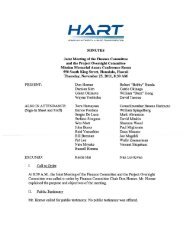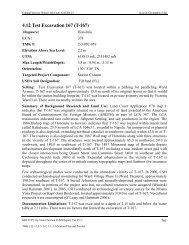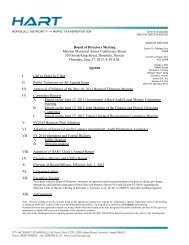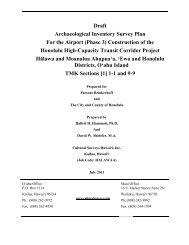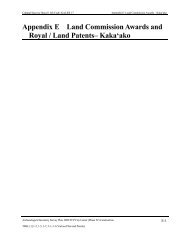Section 2 Mythological and Traditional Accounts
Section 2 Mythological and Traditional Accounts
Section 2 Mythological and Traditional Accounts
Create successful ePaper yourself
Turn your PDF publications into a flip-book with our unique Google optimized e-Paper software.
Cultural Surveys Hawai‘i Job Code: HALAWA 13<br />
<strong>Mythological</strong> <strong>and</strong> <strong>Traditional</strong> <strong>Accounts</strong><br />
<strong>Section</strong> 2 <strong>Mythological</strong> <strong>and</strong> <strong>Traditional</strong> <strong>Accounts</strong><br />
The review of <strong>Mythological</strong> <strong>and</strong> <strong>Traditional</strong> <strong>Accounts</strong> presented below is largely drawn from<br />
that presented in the SHPD-accepted AISP (Hammatt <strong>and</strong> Shideler 2011: <strong>Section</strong> 2, pages 15 to<br />
21) for this portion of the HHCTCP. That AISP asserts that the “cultural background section will<br />
be augmented in the subsequent AIS report through the incorporation of the results of Kumu<br />
Pono Associates <strong>and</strong> SRI Foundation’s ongoing TCP/ethnographic/ethnohistoric studies for the<br />
Airport vicinity.” (Hammatt <strong>and</strong> Shideler 2011: 15, 117) This is addressed in Appendix A: Place<br />
Names, Wahi Pana, <strong>and</strong> a Synthesis of Data from Ethnographic/ Ethnohistoric Studies.<br />
The present study corridor traverses most of the width of the traditional Hawaiian l<strong>and</strong> unit<br />
(ahupua‘a) of Hālawa (in the traditional district of ‘Ewa) <strong>and</strong> the entire width of Moanalua<br />
Ahupua‘a (in the traditional district of Kona) (Figure 6). The extreme east end of the study<br />
corridor lies on fill l<strong>and</strong>s seaward of the traditional l<strong>and</strong>s of Kahauiki Ahupua‘a <strong>and</strong> Kalihi<br />
Ahupua‘a. The study corridor enters a small area of the traditional l<strong>and</strong>s of Kalihi Ahupua‘a<br />
along the west bank of Kalihi Stream.<br />
2.1 Hālawa<br />
In 1873, S. K. Kuhano wrote about ancient O‘ahu l<strong>and</strong> divisions. O‘ahu was divided into six<br />
moku or districts: Kona, ‘Ewa, Wai‘anae, Waialua, Ko‘olauloa <strong>and</strong> Ko‘olaupoko. These moku<br />
were further divided into 86 ahupua‘a. Within ‘Ewa, there were 12 ahupua‘a. They were listed<br />
as Hālawa, ‘Aiea, Kalauao, Waimalu, Waiau, Waimano, Manana, Wai‘awa, Waipi‘o, Waikele,<br />
Hō‘ae‘ae, <strong>and</strong> Honouliuli. (Kame‘eleihiwa 1992:330) Modern maps <strong>and</strong> l<strong>and</strong> divisions still<br />
follow the ancient system <strong>and</strong> use the same l<strong>and</strong> divisions, with the exception that a distinction is<br />
made between North <strong>and</strong> South Hālawa. This division in the case of Hālawa is due to a l<strong>and</strong><br />
court decision which occurred in 1888.<br />
Considering its rich <strong>and</strong> varied environment—coastal <strong>and</strong> stream resources, central plains for<br />
lo‘i, <strong>and</strong> upl<strong>and</strong> forest regions—information regarding pre-Contact <strong>and</strong> early post-Contact life in<br />
Hālawa is sketchy, especially for the upl<strong>and</strong> sections. The majority of the early historic<br />
references speak of the fishponds at Pu‘uloa (the Hawaiian name for Pearl Harbor), the coastal<br />
resources, <strong>and</strong> excursions by early visitors to the Pearl River (known variously in Hawaiian as<br />
“Wai momi” “Awalau” <strong>and</strong> “Pu‘uloa”; see Sterling <strong>and</strong> Summers 1978:46). Most early<br />
references in the traditional literature are one-line passages that merely mention Hālawa in<br />
passing with little attention to detail. People traveled through Hālawa from ‘Ewa to Honolulu or<br />
vice versa, but most of these travels seem to have taken place inl<strong>and</strong> of the Āliamanu <strong>and</strong> Salt<br />
Lake (Āliapa‘akai) craters <strong>and</strong> well inl<strong>and</strong> of the current study area (Figure 7). Once the trail left<br />
the northeast margin of the East Loch of Pearl Harbor, it could have been traversed quickly<br />
across the one mile (1.6 km) width of Hālawa Ahupua‘a by a traveler heading to Kona District.<br />
Perhaps this explains the ‘ōlelo no‘eau (Hawaiian proverb) ‘Ike ‘ole ‘ia aku Hālawa lā; Āina i ka<br />
mole o ‘Ewa lā. (Hālawa is not to be seen; ‘tis a l<strong>and</strong> at the end of ‘Ewa; Forn<strong>and</strong>er 1918:606).<br />
This may be a reference to the location of Hālawa on the fringes of ‘Ewa District in relation to<br />
Waipi‘o in central ‘Ewa, which was the center of politics during pre-Contact times.<br />
Archaeological Inventory Survey, HHCTCP - Airport (<strong>Section</strong> 3) , Hālawa <strong>and</strong> Moanalua Ahupua‘a, O‘ahu, Hawai‘i 16<br />
TMK <strong>Section</strong>s [1] 1-1 <strong>and</strong> 9-9
Cultural Surveys Hawai‘i Job Code: HALAWA 13<br />
<strong>Mythological</strong> <strong>and</strong> <strong>Traditional</strong> <strong>Accounts</strong><br />
Figure 6. Ahupua‘a map of Airport <strong>Section</strong> 3 Archaeological Study Area<br />
Archaeological Inventory Survey, HHCTCP - Airport (<strong>Section</strong> 3) , Hālawa <strong>and</strong> Moanalua Ahupua‘a, O‘ahu, Hawai‘i 17<br />
TMK <strong>Section</strong>s [1] 1-1 <strong>and</strong> 9-9
Cultural Surveys Hawai‘i Job Code: HALAWA 13<br />
<strong>Mythological</strong> <strong>and</strong> <strong>Traditional</strong> <strong>Accounts</strong><br />
Figure 7. Map of trails <strong>and</strong> places mentioned by John Papa ‘Ī‘ī (adapted from Rockwood’s map<br />
in ‘Ī‘ī 1959:96)<br />
Archaeological Inventory Survey, HHCTCP - Airport (<strong>Section</strong> 3) , Hālawa <strong>and</strong> Moanalua Ahupua‘a, O‘ahu, Hawai‘i 18<br />
TMK <strong>Section</strong>s [1] 1-1 <strong>and</strong> 9-9
Cultural Surveys Hawai‘i Job Code: HALAWA 13<br />
<strong>Mythological</strong> <strong>and</strong> <strong>Traditional</strong> <strong>Accounts</strong><br />
A fourteenth century account speaks of the reign of Mā‘ili-kūkahi, an ali‘i kapu (sacred<br />
chief) who was born at Kūkaniloko in Wahiawā around the fourteenth century A.D. (Pukui et al.<br />
1974:113) After consenting to become mō‘ī (king) at the age of 29, Mā‘ili-kūkahi was taken by<br />
the chiefs to live at Waikīkī. The story tells us that he was probably one of the first chiefs to live<br />
there. Up until this time, the chiefs had always lived at Waialua <strong>and</strong> ‘Ewa. Under his reign, the<br />
l<strong>and</strong> divisions were reorganized <strong>and</strong> redefined. In reference to the productivity of the l<strong>and</strong> <strong>and</strong><br />
the population (including at Hālawa) during Mā‘ili-kūkahi’s reign, Kamakau writes:<br />
In the time of Mā‘ili-kūkahi, the l<strong>and</strong> was full of people. From the brow, lae, of<br />
Kulihemo to the brow of Maunauna in ‘Ewa, from the brow of Maunauna to the<br />
brow of Pu‘ukea [Pu‘u Ku‘ua] the l<strong>and</strong> was full of chiefs <strong>and</strong> people. From<br />
Kānewai to Halemano in Wai‘alua, from Halemano to Paupali, from Paupali to<br />
Hālawa in ‘Ewa the l<strong>and</strong> was filled with chiefs <strong>and</strong> people. (Kamakau 1991:55)<br />
Oral tradition tells us that Hālawa was the home of Papa, where she lived in the upl<strong>and</strong>s with<br />
her parents, Kahakauakoko <strong>and</strong> Kūkalani‘ehu. Papa is known for her generative role as the<br />
“earth mother.” Together with her husb<strong>and</strong>, Wākea, they were the progenitors of the Hawaiian<br />
race. The Hale o Papa heiau (pre-Christian place of worship) <strong>and</strong> ritual, which is the female<br />
component of the ancient luakini (large heiau where ruling chiefs prayed <strong>and</strong> human sacrifices<br />
were offered) ritual, probably takes its name from her. The Hale o Papa was the heiau for the<br />
female deities. Only chiefesses of the highest ranks were allowed to enter <strong>and</strong> partake of the<br />
specially dedicated foods (Valeri 1985:245; ‘Ī‘ī 1959:39; Kamakau 1961:179, 380).<br />
Mention is made of the travels of Kamapua‘a (the famous pig-god) through Hālawa <strong>and</strong> of<br />
the cave, Keanapua‘a, where he slept (Kame‘eleihiwa 1996:131).<br />
In the name chant for Kaumuali‘i, reference is made to “ka ea nō mai Hālawa a Honouliuli”<br />
(the whirlwind which blows from Hālawa to Honouliuli) (Forn<strong>and</strong>er 1916 Vol. VI: 475).<br />
In traditional lore, Hālawa was one of several places noted <strong>and</strong> remembered for its ‘awa<br />
(Piper methysticum the source of a narcotic drink) (Forn<strong>and</strong>er 1916 Vol. V: 610). One account<br />
tells us that the first ‘awa plant was brought to Hawai‘i by Oilikūkaheana from Kahiki (Tahiti)<br />
<strong>and</strong> planted on Kaua‘i. He brought it to Hawai‘i for use in fishing. [The use of ‘awa as an<br />
offering to a shark guardian by fishermen is noted in H<strong>and</strong>y <strong>and</strong> H<strong>and</strong>y 1972:192.] Mō‘īkehā<br />
brought some ‘awa plants with him to O‘ahu <strong>and</strong> planted them at Hālawa. When they grew, he<br />
mentioned it to Oilikukaheana, who told him that the name of these ‘awa plants was Paholei.<br />
Mō‘īkehā forgot the name <strong>and</strong> later, when the plants were much larger, he went to ‘Ewa <strong>and</strong> told<br />
her about the plants. ‘Ewa sent Mō‘īkehā to get some plants. ‘Ewa said:<br />
Let me first eat of this plant, <strong>and</strong> should I die, do not plant it for it would be<br />
valueless; but should I not die, then we will be rich.” When ‘Ewa ate it she<br />
became drunk <strong>and</strong> was intoxicated all day. When she awoke she called the plant<br />
“awa”; from thence forward this plant was called ‘awa, the awa of Kaumaka‘eha,<br />
the chief. (Forn<strong>and</strong>er 1916 Vol. V: 608)<br />
On the 12th of December, 1794 the decisive battle of Kūki‘iahu took place at Kalauao (lit.<br />
the multitude of clouds), approximately a mile (1.6 km) northwest of the current study area. It<br />
was there that the O‘ahu ruling chief Kalanikūpule defeated <strong>and</strong> killed the invader Ka‘eokūlani.<br />
It is said that the dead bodies were gathered up <strong>and</strong> taken to Pa‘aiau where they were piled in a<br />
Archaeological Inventory Survey, HHCTCP - Airport (<strong>Section</strong> 3) , Hālawa <strong>and</strong> Moanalua Ahupua‘a, O‘ahu, Hawai‘i 19<br />
TMK <strong>Section</strong>s [1] 1-1 <strong>and</strong> 9-9
Cultural Surveys Hawai‘i Job Code: HALAWA 13<br />
<strong>Mythological</strong> <strong>and</strong> <strong>Traditional</strong> <strong>Accounts</strong><br />
great heap. Among the piled-up bodies was Kahulunuika‘aumoku, daughter of Kū‘ohu, a Kaua‘i<br />
kahuna who had been slain with Ka‘eokūlani. Late at night, an owl woke her up by flying over<br />
<strong>and</strong> beating its wings on her head. The owl flew makai <strong>and</strong> she crawled after it until reaching the<br />
sea. She then swam to the other side at ‘Aiea, where the owl appeared once more <strong>and</strong> led her up<br />
to the mountains in Hālawa valley. There, she took shelter in a cave <strong>and</strong> fell into an unconscious<br />
sleep. The owl flew to a former kahu (caretaker) of hers who “knew the country well around<br />
Hālawa.” This kahu brought her food <strong>and</strong> nursed her back to health (Kamakau 1961:169-70).<br />
During the construction of the H-3 freeway, Mālama o Hālawa protesters used this story as<br />
basis for claiming Hālawa’s importance to women. They maintained that Hālawa was an<br />
important <strong>and</strong> special healing site for women in times past <strong>and</strong> that it was also home of the<br />
protective ‘aumakua (guardian), the pueo (owl).<br />
The following mo‘olelo are accounts regarding people <strong>and</strong> events that took place in or near<br />
Hālawa. These accounts are what have been preserved through the oral <strong>and</strong> written record of<br />
times long past.<br />
Leilono - a supernatural breadfruit tree (‘Ulu o Leiwalo) whose branches appeared through a<br />
hole in the ground. This hole was said to be the entrance whereby w<strong>and</strong>ering spirits could enter<br />
the afterworld of Milu (pō pau ‘ole), the ao kuewa or realm of w<strong>and</strong>ering spirits, or the ao<br />
‘aumakua (ancestral spirit realm). The tree had two branches which were deceiving to look at,<br />
one on the east side of the tree <strong>and</strong> one on the west side. If a spirit climbed onto the west branch,<br />
it would wither <strong>and</strong> break off <strong>and</strong> he would plunge into the realm of Milu. If a spirit climbed<br />
onto the branch on the east, he would be able to see the ‘aumākua realm <strong>and</strong> receive help from<br />
his ancestors. This hole is described as being round <strong>and</strong> approximately two feet wide, on a piece<br />
of pāhoehoe lava. Leilono is in the neighboring district of Moanalua. However, very specific<br />
boundaries are given for it. Kamakau says it was:<br />
close to the rock Kapūkakī <strong>and</strong> easterly of it . . .directly in line with the burial<br />
mound of Āliamanu <strong>and</strong> facing toward the right side of the North Star….The<br />
boundaries of Leilono were Kapapakōlea on the east, [with] a huge caterpillar<br />
(pe‘elua nui) called Koleana as its eastern watchman, <strong>and</strong> the pool Napeha on the<br />
west, with a mo‘o the watchman there. If the soul was afraid of these watchmen<br />
<strong>and</strong> retreated, it was urged on by the ‘aumakua spirits, then it would go forward<br />
again <strong>and</strong> be guided to the ‘aumakua realm. If a soul coming from the Ālia<br />
(Āliapa‘akai) side was afraid of the caterpillar, whose head peered over the hill<br />
Kapapakōlea, <strong>and</strong> who blocked the way, it would w<strong>and</strong>er about close to the<br />
stream by the harness shop. This was not the government road (alanui aupuni) of<br />
former times, but was a trail customarily used by “those of Kauhila‘ele”<br />
[figuratively, the common people; the la‘ele, old taro leaves, as contrasted with<br />
the liko, the new <strong>and</strong> choicer leaves — that is, the chiefs]. It was said that if a<br />
w<strong>and</strong>ering soul entered within these boundaries it would die by leaping into the<br />
pō pau ‘ole; but if they were found by helpful ‘aumākua souls, some w<strong>and</strong>ering<br />
souls were saved. Those who had no such help perished in the pō pau ‘ole of<br />
Milu. (Kamakau 1964:48-49).<br />
Archaeological Inventory Survey, HHCTCP - Airport (<strong>Section</strong> 3) , Hālawa <strong>and</strong> Moanalua Ahupua‘a, O‘ahu, Hawai‘i 20<br />
TMK <strong>Section</strong>s [1] 1-1 <strong>and</strong> 9-9
Cultural Surveys Hawai‘i Job Code: HALAWA 13<br />
<strong>Mythological</strong> <strong>and</strong> <strong>Traditional</strong> <strong>Accounts</strong><br />
The Napeha pool referred to above as a boundary of Leilono was approximately 1.5 km northeast<br />
of the current study area. We know of no subsequent reference to “the burial mound of<br />
Āliamanu” but Āliamanu Crater lies approximately 1.7 km to the northeast.<br />
Nāpēhā - a pool <strong>and</strong> resting place where people went diving. So named because Kūali‘i stopped<br />
<strong>and</strong> bent over the pool to take a drink. The name means “bend over breath” (‘Ī‘ī 1959:95). [Note:<br />
Sterling <strong>and</strong> Summers (1978:10) give the literal meaning as “out of breath.” Also, see Pukui et<br />
al. 1974:163 <strong>and</strong> Pukui <strong>and</strong> Elbert 1986:262 for variations in diacritical markings.]<br />
Kauwamoa - a diving place where people liked to gather. It was said that Pe‘ape‘a (son of<br />
Kamehamehanui of Maui) liked to dive from a favorite spot which was five to ten fathoms above<br />
the pool (‘Ī‘ī 1959:95).<br />
Waikahi Heiau - Site 105. The location was described by McAllister as being “on the flat area<br />
on the mountain side of the road where the two gulches of Hālawa meet. According to Thrum,<br />
the size was about 80 square feet. It was a po‘okanaka (sacrificial heiau) <strong>and</strong> Manuuokao was<br />
the kahuna. [In 1933, McAllister reported the area was entirely planted in cane <strong>and</strong> no remains<br />
whatsoever could be seen (p. 103).]<br />
Waipao Heiau - Site 106. McAllister lists the location as being “near the mouth of Kamananui<br />
Gulch, Hālawa.” He goes on to say:<br />
The structure was on a narrow flat at the entrance of a small ravine running into<br />
the north wall of the gulch. The heiau was destroyed a few years ago when there<br />
was an attempt to plant cane on this l<strong>and</strong>, <strong>and</strong> the lines of stones which follow the<br />
old furrows are all that remain. My Hawaiian informant told me that the<br />
surrounding caves were formerly used as places of burial. (McAllister 1933:103)<br />
Kūnānā Pond - said to be at the base of Hālawa stream <strong>and</strong> was at one time connected with<br />
Kūāhua Isl<strong>and</strong>. It was named after Kūanānā (child of Nānā) who liked to fish there. She was the<br />
mother of Ka‘ahupahau, the shark guardian of Pu‘uloa. (Sterling <strong>and</strong> Summers 1978:10)<br />
Keanapua‘a Point - (lit. the pig’s cave) So named because Kamapua‘a, the legendary pig-god<br />
slept in the cave overnight. It is near the beach in Hālawa opposite Waipi‘o Peninsula. (Sterling<br />
<strong>and</strong> Summers 1978:10<br />
Kamapua‘a (Story of) - upon awaking, after spending the night at Keanapua‘a, Kamapua`a<br />
urinated in the ocean. This is the reason the fish at Pu‘uloa have such a strong smell. (Sterling<br />
<strong>and</strong> Summers 1978:10<br />
Kahuawai - a small waterfall on Kalauao stream which was a favorite resting place exclusively<br />
for chiefs. It was also called Kahuewai (the water gourd) (Pukui, et al 1974:66). [It was also<br />
referred to by J. ‘Ī‘ī (1959:20) as “a l<strong>and</strong> with two points” because the fish they were carrying<br />
(as food) was stiff <strong>and</strong> bent like hog tusks by the time they reached this resting spot.]<br />
2.2 Moanalua<br />
The present study area traverses the seaward portion of Moanalua Ahupua‘a, the westernmost<br />
of the traditional Hawaiian l<strong>and</strong> divisions (ahupua‘a) of the traditional Kona District (Kona<br />
Moku). There are numerous references to Moanalua in the traditional literature which may<br />
Archaeological Inventory Survey, HHCTCP - Airport (<strong>Section</strong> 3) , Hālawa <strong>and</strong> Moanalua Ahupua‘a, O‘ahu, Hawai‘i 21<br />
TMK <strong>Section</strong>s [1] 1-1 <strong>and</strong> 9-9
Cultural Surveys Hawai‘i Job Code: HALAWA 13<br />
<strong>Mythological</strong> <strong>and</strong> <strong>Traditional</strong> <strong>Accounts</strong><br />
provide preliminary clues to the character of life - including patterns of settlement <strong>and</strong> l<strong>and</strong><br />
usage - within the ahupua‘a of Moanalua during pre-western contact times.<br />
The nineteenth-century Hawaiian archivist <strong>and</strong> historian Samuel Kamakau mentions<br />
Moanalua in an account of the mo‘olelo (legend) surrounding the arrival of the gods Kū <strong>and</strong><br />
Lono to the Hawaiian Isl<strong>and</strong>s:<br />
Kū <strong>and</strong> Lono are spoken of in the mo‘olelo of the lono-pūhā practitioners <strong>and</strong> of<br />
the medical kāhuna as having come from Kahiki [Tahiti]. They l<strong>and</strong>ed first on<br />
Kaua‘i, <strong>and</strong> from there they spread forth.<br />
In the mo‘olelo of Pele mā, it says that they first l<strong>and</strong>ed at Kalihi on Kaua‘i <strong>and</strong><br />
from there went to Ka‘ena Point on O‘ahu <strong>and</strong> at Moana-lua left the salt pond.<br />
Then they went to Ka-uha-kō on Moloka‘i, to ‘Aleamai in Hāna, Maui, <strong>and</strong> then<br />
went to live at Kīlauea in Puna <strong>and</strong> Ka‘ū on Hawai‘i. (Kamakau 1991:112)<br />
The "salt pond" of Moanalua is Āliapa‘akai or Salt Lake - the 0.9 mile wide body of water<br />
that once stretched across a crater of the same name, <strong>and</strong> which was filled during the 1970s to<br />
construct a golf course.<br />
Another tradition associates the creation of Āliapa‘akai (Salt Lake) <strong>and</strong> the nearby adjacent<br />
Āliamanu Crater with the goddess Pele:<br />
...[Pele] left Kauai <strong>and</strong> went to Oahu, to a place near Honolulu, to Moanalua, a<br />
beautiful suburb. There she dug a fire pit. The earth, or rather the eruption of lava,<br />
was forced up into a hill which later bore the name Ke-alia-manu (The Bird White<br />
Like a Salt Bed or The White Bird). The crater which she dug filled up with salt<br />
water <strong>and</strong> was named Ke-alia-paa-kai (The White Bed of Salt, or Salt Lake).<br />
(Westervelt 1987:40)<br />
Near Āliapa‘akai <strong>and</strong> Āliamanu was Leilono, an entrance to the nether world:<br />
Leilono at Moanalua, Oahu, was close to the rock Kapukaki <strong>and</strong> easterly of it (a<br />
ma ka na‘e aku), directly in line with the burial mound of Aliamanu <strong>and</strong> facing<br />
toward the right side of the north Star (a huli i ka ‘ao‘ao ‘akau o ka Hokupa‘a).<br />
On the bank of the old trail there was a flat bed of pahoehoe lava, <strong>and</strong> on it there<br />
was a circular place about two feet in circumference. This was the entrance to go<br />
down. . .(ka puka o Leilono)...(Kamakau 1964:48)<br />
Additional legendary personages associated with Moanalua include the "cannibal dog-man<br />
Kaupe who overthrew the government of Ka-hānai-a-ke-akua (“Reared by the gods”) <strong>and</strong> ruled<br />
the l<strong>and</strong> from Nu‘uanu to the sea" (Beckwith 1970:345). Another legend tells of a father <strong>and</strong> son<br />
who "flee <strong>and</strong> hide under a rock at Moanalua while Kaupe goes on to look for them on Hawaii"<br />
(Beckwith 1970:345). Other traditions identify Moanalua with historical personages including<br />
the most prominent Hawaiian ali‘i (royalty).<br />
Samuel Kamakau recounts the story of a Maui chief:<br />
named Kalai-koa who lived at Moanalua built a long house <strong>and</strong> named it<br />
Kauwalua <strong>and</strong>, perhaps in order to make his name famous, had it filled with the<br />
bones of persons stripped, bound, <strong>and</strong> set up inside the house <strong>and</strong> all around the<br />
outside enclosure of the house. The bones of Elani, Kona-manu, <strong>and</strong> Ka-laki-o‘o-<br />
Archaeological Inventory Survey, HHCTCP - Airport (<strong>Section</strong> 3) , Hālawa <strong>and</strong> Moanalua Ahupua‘a, O‘ahu, Hawai‘i 22<br />
TMK <strong>Section</strong>s [1] 1-1 <strong>and</strong> 9-9
Cultural Surveys Hawai‘i Job Code: HALAWA 13<br />
<strong>Mythological</strong> <strong>and</strong> <strong>Traditional</strong> <strong>Accounts</strong><br />
nui were bundled up <strong>and</strong> placed beside the entrance. The house stood at Lapakea<br />
on the slope into Moanalua on the upper side of the old road. Eyewitnesses said,<br />
`It was a terrible <strong>and</strong> gruesome sight. The bones were stripped, bundled together,<br />
<strong>and</strong> the skulls set upon each bundle so that, seen from a distance, it looked like a<br />
company of living men.' (Kamakau 1961:138-139)<br />
The existence of the "house of bones" into the nineteenth century is confirmed in accounts by<br />
early western visitors to Moanalua <strong>and</strong> its conjectured location (approximately 2 km northwest<br />
of the Lagoon Drive Station) was recorded as an archaeological site (Site 85, see Figure 28 <strong>and</strong><br />
discussion of Site 85 in <strong>Section</strong> 4.4) during the first archaeological survey of O‘ahu during the<br />
early 1930s.<br />
Archaeological Inventory Survey, HHCTCP - Airport (<strong>Section</strong> 3) , Hālawa <strong>and</strong> Moanalua Ahupua‘a, O‘ahu, Hawai‘i 23<br />
TMK <strong>Section</strong>s [1] 1-1 <strong>and</strong> 9-9



